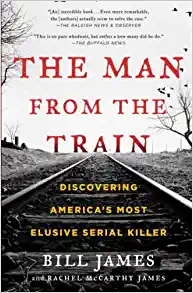By Bill James and Rachel McCarty James
 Baseball statistician and historian Bill James is one of the few people who could have written this book about a string of family killings between 1898 and 1912, ranging from Florida to Maine and Georgia to Washington state.
Baseball statistician and historian Bill James is one of the few people who could have written this book about a string of family killings between 1898 and 1912, ranging from Florida to Maine and Georgia to Washington state.
He and his daughter, co-author Rachel McCarthy James, believe they can identify the itinerant, train-hopping serial killer responsible for an estimated 95 murders. (Another four people were legally executed and seven lynched after juries or angry community members falsely convicted them of killings committed by the “man from the train,” according to James.)
Before retiring, James analyzed baseball statistics to learn why teams win and lose. He and his daughter combined exhaustive research, newspaper reviews and statistical evaluation to arrive at the theories they present in this book.
James’ interest was peaked by the 1912 killings of six children and two adults, bludgeoned to death with an axe in Villisca, IA. The killings remain unsolved. A number of authors, including ones in 1912, observed that there were other, similar killings in surrounding states.
Clearly, the Villisca murders were the work of an efficient, experienced killer. But what if, Bill asked, you could research earlier, similar murders until you came to this killer’s beginnings. In his early years, when he was less experienced and more prone to mistakes, it might be possible to find keys to his identity.
Through their research, the Jameses identified 33 characteristics that mark the work of the Man from the Train. They make a convincing case that they have, indeed, identified “the Man from the Train.”
This is a fascinating book for any true crime or history buff. The decade between 1900 and 1910 heralded changes that made it increasingly difficult for a serial killer to go unnoticed. In 1900, fingerprinting was not widely used in forensics. Basic blood groups were known but not used by the police until about 1912.
During those years, residential electricity expanded; homes began to have telephones; flashlights became available; and cars were taking over the roads. Literacy rates were rising. Newspapers grew bigger and more available. Services like the Associated Press and United Press International allowed local crime stories to become national news.
The authors can only speculate as to why the murders stopped in 1912. James suggests the killer died or was imprisoned for another crime. Perhaps age took its toll. The person they believe is the killer was of German origins. Perhaps he left the country. James has even found a multi-victim killing spree in Germany at approximately the right point in time to be the Man from the Train if, indeed, he left the country.
Like so much of this story, there’s simply no proof.
For all of its fascinating facts and interesting history, this book has a lot of flaws. The writing is often tastelessly casual. Bill keeps taking center stage in his story-telling. The book is repetitive and unfocused. The narration moves backward and forward in time making it easy to get confused.
All of that said, the authors have done an admirable job of research and make a persuasive case that a prolific serial killer was riding the rails in the early years of the 20th century.
The Authors: Bill James (1949 – ) and Rachel McCarthy James
Bill (George William) James is a baseball writer, historian and statistician who has written more than two dozen books on baseball history and statistics since 1977. He analyzes baseball using statistical data to learn why teams win and lose. He was hired as a senior adviser for the Boston Red Sox and worked for the team for 17 years during which they won four World Series championships.
His approach, as applied by Oakland Athletics general manager Billy Beane, was featured in the Michael Lewis’ book MONEYBALL. He calls his statistical approach sabermetrics.
In 2006, Time magazine named him in the Time 100 as one of the most influential people in the world.
Born in Holton, KS, he attended the University of Kansas as a scholarship student. He joined the Army in 1971 and was the last person from Kansas to be sent to serve in Vietnam War, although he never saw action there. He was stationed in South Korea for two years.
In addition to his books on basketball, he has written one other true crime book: POPULAR CRIME: REFLECTIONS ON THE CELEBRATION OF VIOLENCE (2011).
Rachel McCarthy James is a journalist whose work has appeared in Hazlitt, Bitch, McSweeney’s, The Week and Robot Butt. She grew up in Lawrence, KS, where she now lives. She studied creative writing and political science at Hollins University in Roanoke, VA.
#BillJames #RachelMcCartyJames #TheManFromTheTrain #JeannetteHartman


